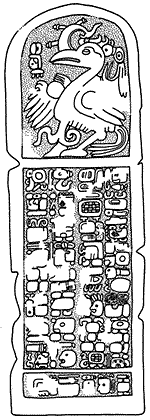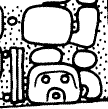


|
The monument as it appears today was found by Dr. Peter Schmidt, current director of the Archaeological Project of Chichen Itza, near Structure 3C9 ("La Casa Colorada") and Structure 3C7 ("The Deer House"). (See note 1.) He assembled it from numerous fragments. It is not currently on exhibition at the site.
In its general configuration the monument looks like a stela, although the shape of the butt remains unclear. Since Sylvanus Morley already used the designation "Stela 1" for the square monument found in the stairway niche from Structure 3C15 ("The Caracol") without regard to its original use, I propose to avoid further confusion by naming the new monument "Stela 2". The monument measures 210 cm by 72 cm and is sculptured only on the front side. The sculptured area measures 193 cm by 57 cm. It is divided into three parts. The upper register is iconographic with a short hieroglyphic text, while the middle register displays a long one. The lower register consists of a single line of hieroglyphs. |

|

| The iconography is of a bird with short wings. From the top of its beak grows some unidentified object with "knife"-like attachments. Under the body of the creature, but in front of its legs, seems to be a kind of "fire scroll". The creature is very similar to those found on the front side of Lintel 1 of Structure 7B4 ("The Temple of the Four Lintels") and on the front side of Yula Lintel 1. But in contrast to the stela, those from the lintels display "knives" of some sort in their feather costumes at the back of their bodies, while from their beaks emerge anthropomorphic faces that speak (note the volutes in front of their faces). |
| In the case of the stela no such face emerges. Instead a short hieroglyphic text on the left side seems to mention 'u k'aba-?-hi', which probably should be translated as "is its name" or "its name" or even "its naming", although no name precedes this statement, unless the head itself in block E2 should be the name. (See note 2.) If this last suggestion were to be the case, then it leads to the conclusion that the "name tagging" does not refer to the bird itself but to the human face, which in the other two instances shows up inside the bird's beak. Therefore it is not unlikely that the bird itself should be considered more as a metaphor, although its concrete meaning is still uncertain. |
 E1-2
E1-2
|
 D10
D10
| The middle register displays a long hieroglyphic text which ends with the date 1 Tun 12 Ahaw (D10), equivalent to the Long Count 10.3.1.0.0 10 Ahaw 18 Xul (AD 890). (See note 3.) This same date is mentioned on the square monument designated Stela 1 by Sylvanus Morley from Structure 3C15. In both cases this seems to be the Tun or Year in which the monuments were carved or erected. Therefore it seems to be highly probable that they are contemporaneous. |
|
The long text starts with the so-called "introduction"-expression at block A3 and the statement that the carving was done (B3-A4). The next information records that the monument was set up (B4), although without the usual mention of a "stone" or a "banner stone". Instead there is a reference to k'ak', "fire" (A5). It is not clear if this has something to do with the fact that the bird-like creature itself displays some kind of fire scroll. It may simply record other information of unknown meaning. The following hieroglyphic blocks are very opaque. Although they record numbers in the form of bars, it seems very unlikely that they refer to a date. Either they are still part of the nominal phrase from block B4 or they record an unknown event. It is not clear if the next sentence starts up in block B6, but at least it shows the T181 ha and T178 la signs, which sometimes function as a verbal morpheme. The hieroglyphs of two further blocks can be recognized. At B9 is the expression ahaw, "lord", and in A10 the hieroglyphs tu BUTS'/K'AK' TILIW-wi, "(for the) Fire Burning?". The precise meaning must remain open to discussion. |

|

|
It is hard to tell where the next syntactic unit begins, but it could be in block D3, although the meaning is still unclear. What follows in the next block (C4) is not the name of K'ak'upakal, but the hieroglyphs ?-PAKAL-la, "(something) shield" to which seems to be attached the Yahawte' title (translation still uncertain). In block D5 a similar hieroglyphic compound can be observed as on Morley's Stela 1 (block L2). This may indicate that both monuments refer to the same individual. Therefore this would be the fourth person at Chichen Itza to include in his name phrase the word Pakal. This raises the question if Pakal should be considered some kind of dynastic name similar to the name Ahk for Piedras Negras or Bahlam for Yaxchilan. Although it seems that the same phrase continues, the meaning of the following blocks again remains opaque. In block C7 a yitah "companion"-expression can be found, which indicates that the still-unknown person was accompanied by somebody (C8), which has to be the same woman known from the lintel of structure 7B1 ("The Temple of the One Lintel"), as correctly identified by Peter Schmidt (personal communication). This is also confirmed by the tentative later date deciphered on the lintel, 10 Tun 10 Ahaw as I propose it, which gives a date 10.4.10.0.0 11 Ahaw 8 Kayab (AD 918) in terms of the Long Count. This woman was herself accompanied, as can be seen from the second yitah-statement at block D8, by somebody whose hieroglyphs are not at all clear, although the last block records K'ak' Pakal (C10). |
But this K'ak' Pakal cannot be identical with K'ak'upakal, because of the missing u due to the use of the logograms K'AK' and PAKAL instead of the usual syllabic writing k'a-k'u-pa-ka-la, unless the two cartouches above the K'AK'- and the PAKAL sign were part of the T604 k'u-sign, which could reflect the way K'ak'upakal is written on the square monument from Structure 3C15. Nevertheless, in view of this unusual writing of the name and of the woman mentioned on the later-dated lintel from Structure 7B1, I propose that on this stela a dynastic history is recorded based on the woman, who is actually the mother of K'inil Ko-?-l(a), and probably of K'ak'upakal, who is not mentioned on any other monuments from the time period between 10.2.0.0.0 (AD 869) and 10.3.0.0.0 (AD 889) in Chichen Itza, except for the contemporaneous Stela 1.

The two dates on the stela are therefore separated by almost 20 Tuns or Years. Although it seems that the later date should be near to the carving or erection of the monument, I still have no idea what kind of event the second date refers to, almost 20 years earlier. Also it is still unexplainable why this date was recorded separately from the main text of the monument. In chronological terms it comes closest to the dates of the inscriptions of Structure 3C9 ("La Casa Colorada"), next to which the monument was found. Therefore I propose that the "fire event" of the stela has something to do with the fire events mentioned in the frieze inscription of Structure 3C9, although the monument itself and the dynastic history as it seems to be recorded links it to a slightly later epoch of Chichen Itza history.
1. About two decades ago, Berthold Riese (personal communication) noticed several fragments of a monument just in the location where Peter Schmidt found the main part of the new inscription. Therefore they might be considered as part of the same monument. (back) 2. The T136 hi-sign could work here as a grammatical morpheme transforming the nominal expression u k'aba into a verb, since it is normally attached to a verbal and not a nominal lexeme. (back) 3. Based on GMT 584285 and given as a Julian date. (back) |
|
GRAÑA-BEHRENS, DANIEL 2004 Some Remarks on Chichen Itza Stela 2. Mesoweb: www.mesoweb.com/chichen/features/St2/remarks.html. |
top - home